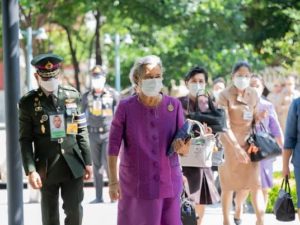On Tuesday, April 23, 2022, Dr Olga Rusova, Second Secretary, Embassy of Ukraine in Bangkok, gave a public lecture on the topic of “Chornobyl – Terra Cognita” at the Faculty of Arts, Chulalongkorn University. This lecture was held as part of the Literature in English Translation course offered by Associate Professor Verita Sriratana, where students read and discuss Svetlana Alexievich’s Voices from Chernobyl: The oral history of the nuclear disaster. Dr Rusova raised various important points regarding the effects which Chornobyl has on the people not only in Ukraine, but also all over the world. We, the students of the Literature in English Translation course, have summarised the lecture into these four parts: “Chornobyl” as a Cultural Trauma, The Irony in Preventing Panic, Ukraine Today: Rebranding Chornobyl, and Chornobyl in Literature and Art.
“Chornobyl” as a Cultural Trauma
In cultural trauma, there are four elements: emotionality that is mostly negative, blame attribution, identity formation processes, and defence mechanisms such as artistic creation.
There is a monologue from Svetlana Alexievich’s Voices from Chernobyl that perfectly captures three of the four elements of cultural trauma. That monologue is called “Monologue about a Damaged Child”. Firstly, we can see the negative emotionality from where the speaker said “People smile less, they sing less at holidays. …Everyone’s depressed. It’s a feeling of doom.” Secondly, it seems like the speaker blamed whoever was writing about them from these sentences: “Sometimes I think it’d be better if you didn’t write about us. Then people wouldn’t be so afraid.” It is like the speaker thought that by telling the truth, it scares people. Finally, “Here, we’re all Chernobylites”, this quotation tells us that people who suffered from Chornobyl are now identified as Chernobylites, and there is also a social stigma attached to the word.
Cultural trauma can create various negative effects. For example, it can affect people’s mental health, leave trauma for generations to come, and make people question their identity. Despite the negative effects, some positive effects can include social unity and empathy.
The Irony in Preventing Panic
After the explosion of the number Four reactor at the Chornobyl Nuclear Power Plant on April 26, 1986, the firstannouncement was made on Prypiat radio on April 27 (approximately 36 hours after the accident) regarding a “temporary evacuation” of the city’s residents. It was the only sign that gave an understanding that something serious had happened to the people.
Informing the public about the disaster and the scale of its consequences was obviously not the Soviet authorities and the media under their control’s highest priority at the time. In Voices from Chornobyl, Vladimir Ivanov, former First Secretary of the Stavgorod Regional Party Committee gave the interview in ‘Monologue about Political Strategy’ that the reason behind the absence of information from the government was to ‘prevent panic’ among the public. And, with the sense of patriotism to the Soviet Union at the time, when the orders came, they believed they did the right thing by following them. Instead, that very same absence of information caused the public to become panic. Rumours were created. Discrimination took place. People suffered. And there was nothing they could do to undo the damage.
Ukraine Today: Rebranding Chornobyl
From the accident in 1986 back when Ukraine was under the control of the Soviet Union, there were obviously negative effects on the word “Chornobyl” since then. The recent president of Ukraine, Volodymyr Zelenskyy, has been trying to change the negative image of Chornobyl to a positive one.
“Chornobyl Excursion Zone”, CEZ or The zone was designed to designate the area around Chornobyl nuclear disaster for restricting access to the area. In 2002, however, the UN published a report that says, the most parts of CEZ were considered safe for humans, leading tourists to come and visit Chornobyl more and more every year since. Moreover, there have been constant waves of interest in CEZ after the release of “S.T.A.L.K.E.R. shadow of Chernobyl” games which lead players around the world to explore places that based on real Chornobyl’s location. And the HBO series, “Chornobyl”, based on Alexievich’s book also attracted people’s interest.
These things not only raise interest in what happened in Chornobyl, but also became some kind of warning. A warning about what could happen if a state prioritises some certain political ideology and the security of the nation before the truths and lives of people. On the bright side, we could see this accident as a pathway to the dissolution of the Soviet Union and the independence movement of Ukraine.
Chornobyl in Literature and Art
The portrayal of Chornobyl in literary works like Svetlana Alexievich’s Voices from Chernobyl depicts the picture of tragedy and despair when people lost their loved ones, their homes, and their ways of living. But despite the memory of sorrow, the flowers of artistry are still blooming on the decaying walls of Prypiat.
We think that there are both similarity and differences between Chornobyl literature and visual art. The stories of Chornobyl were preserved by the victims of the event, until they have a chance to pass it on. Then it was collected, recorded in books, translated into other languages and disseminated across the world. Likewise, the street art in Prypiat remain in the time and place they were created, immovable, until people discovered them and brought them to light by the use of internet. The other difference is that street art does not need literary translation to get the meanings across, but works of literature still depend on literary translation.
There are two main themes in Chornobyl street art shown to us by Dr Olga Rusova: shadows and children. The shadow paintings on the walls are in the posture of being in the middle of some action, interacting with the object or environment around them. The shadows might connote the reflection of people who used to live there in the past through the imagination of the artists. The paintings of young children, playing and smiling, on the walls of Prypiat, serve as a stark contrast to the story of children affected by the radiation and were no longer there. It may be drawn in hope that maybe someday in the future, there would be a new beginning to the place, where children can play and enjoy their lives as children once again.
Final note
There is no denying that Chornobyl disaster, for decades, had caused suffering and pain to many people. However, just like several horrible incidents throughout history, time gradually heals those wounds. People are getting stronger. Many even try to change what the outsider might recognise as horror into something that intrigues them. As a result, what used to be fear and despair turn into arts and hope.
Moreover, the lesson we have learnt from this terrible event is the importance of accepting the truth as how it actually is, even if it is tragic, disturbing, or even undermining the image of your nation. Acknowledging is the first door to fixing or managing problems. We hope that these valuable lessons of Chornobyl will not be retold in vain, so that people in the future will not have to go through such a sorrowful event again.
Written by BA students at the Faculty of Arts, Chulalongkorn University,
Thunrada Juengkajohnkiat,
Bunyawat Thabthonglang,
Natthakan Thongon, and
Thamonwan Sukkasem






